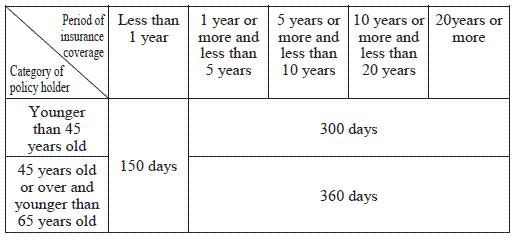|
1. The Employment Insurance System
2. Employment Insurance Benefits
1. The Employment Insurance System
The employment insurance system shall provide
benefits which ensure displaced employees a stable life until they find
a new job. This insurance shall also be provided to foreign employees.
However, oversees public servants, those who are covered by any overseas
unemployment compensation system, and those who are dispatched to establishments
in Japan after being hired abroad, are unable to join this insurance system.
The insurance enrollment procedures will
be undertaken by employers at the appropriate public employment security
office.
< Insurance Premiums >
[New Point]
Insurance premiums shall be paid by both
employer and employee, each of their shares defined according to the employee's
salary/wages.
a. Ordinary enterprises 11/1000, 1.1%
(Employer 7/1000, Employee 4/1000)
b. Enterprises concerning agriculture, forestry and fishery, and brewing, 13/1000, 1.3%
(Employer 8/1000, Employee 5/1000)
c. Constructions industry 14/1000, 1.4%
(Employer 9/1000, Employee 5/1000)
2. Employment Insurance Benefits
When a person insured under the employment insurance
scheme but loses his/her job due to dismissal, bankruptcy or personal circumstances,
etc., and cannot find a job in spite for the will and ability to work, unemployment
benefits are provide to that person. To be eligible for the employment benefits,
the person must have been insured for twelve moths or more in total during the two
years prior to the date of leaving work regardless of the length of designated working
hours per week. If a person was made jobless for the reason of bankruptcy or dismissal,
benefit eligibility is to have been insured for six months or more in total for
one year prior to the date of becoming jobless.
Regarding the calculation for the insured
period, the following method will be applied. If a person worked eleven
days or more per month, it is acknowledged that he/she has eleven days
or mores as a basis of wage payment and it is considered he/she has one
month of insured period . The maximum benefit period is
one year from the day after becoming unemployed and the number of payable days is
stipulated according to the insured period and the age of the worker as given below.
The amount of daily allowance given by the
Employment Insurance is called "the basic daily allowance". The
basic daily allowance amounts to about 50% to 80% (45% to 80% for 60 to
64 year olds) of "daily wages" during employment. (The value
of which is obtained by dividing the total wages of the past six months
just before leaving work, by 180). The maximum amount of the daily allowance
is \7,730 and the minimum amount of daily allowance is \1,648 (as of August,
2009).
"Restriction on benefits" which is usually for 3 months may be applied, in cases when an insured person (an employee) has been discharged due to serious reasons concerning his/her responsibility, or when an insured person has resigned owing to His/her personal circumstances without any valid reason.
To apply, the employee should file "A
separation notice", issued by the employer, with the public employment
security office which controls his/her residential area, and apply for
employment as well. If a worker does not have a status of residence which
enables him/her to work, he/she cannot apply for employment. Therefore,
he/she shall not be able to request unemployment benefit.
The number of payment days for basic allowance
a. Former general employees (Former general employees other than those of categories a. and b.; also retired employees and those who left their jobs of their own accord).

b. Indivisuals who may face difficulty in finding employmemt, such as the
disabled.

c. Those who lost thier jobs due to corporate bankruptcy, dismissal, etc.,
and hence had no time to prepare for re-emplyment.

* When it is particularly difficult for a person who last his/her job as
a result of dismissal or rejection of contract renewal by the employer
to reenter employment, the term of the benefit may be extended for another
sixty days in view of the age, regional differences in employment conditions
and other .( Three-year interim measure)

|